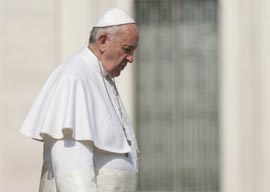
October 27, 2015

Pope Francis
Source: Shutterstock
In this battle between traditionalists in the synod and the bishops who favor acceptance of some or all of Kasper’s recommendations, the pope seems to stand squarely on the side of the reformers.
Yet, it was the Protestant Reformation that destroyed the unity of Catholicism, five centuries ago, as it divided nations and led to conflicts of religion and nationalism, such as the Thirty Years War.
How the Catholic Church can avoid greater confusion among the faithful—after the pope’s virtual blessing of the Kasper recommendations, and the synod’s rejection of them—escapes me.
What does the pope do now?
If he ignores the synod’s dissent and moves the Church toward the Kasper position, he could cause a traditionalist break, a schism. Third World bishops might well refuse to change.
If he does nothing, he will disappoint Western bishops, priests and secularists who have seen in his papacy hope for an historic change in Catholic teaching and practice.
If he permits the bishops to follow their consciences in their dioceses, he will advance the disintegration of the Church.
The inevitable result of any of these courses that the pope chooses will be, it seems, to deepen the confusion of the faithful.
As for Pope Francis himself, he, too, must choose.
He can emulate Cardinal Wolsey—or Thomas More.